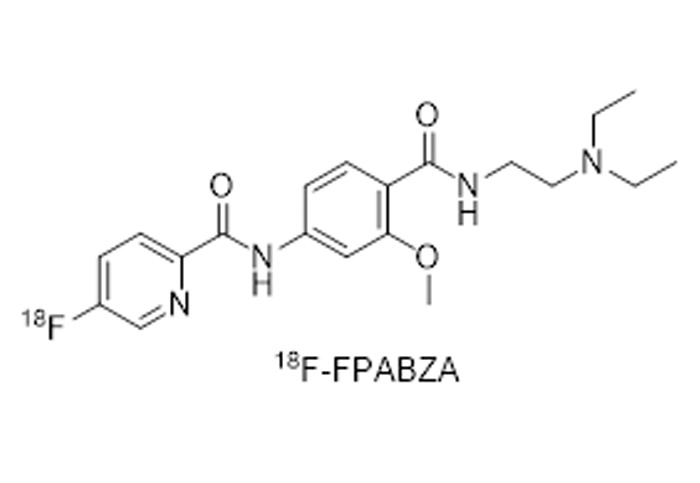
Products
Built multiple sets of modular, multi-functional i↑ntelligent drug automatic synthesis platform
18F-JR1002 material
Keywords: synthetic equipment disposable consumables
Classification:
Tracers

Hotline:
18F-JR1002 material
Graphic Details
18F-JR1002 Materials
1. Drug Name (Generic Name, Chemical Name, English Name, Pinyin, and rationale for custom nam es if any)
Generic Name: 18F-JR1002
Chemical Name: N-[4-( diethylamino ) benzyl ]-4-[2-( fluoro -18F) ethoxy ]-N-( p-tolyl ) benzenesulfonamide
English Name: N-(4-(diethylamino)benzyl)-4-(2-(fluoro- 18 F)ethoxy)-N-(p-tolyl)benzenesulfonamide
Pinyin: 18F-JR1002
2. Drug chemical structure, molecular weight, molecular formula
Chemical Structure:

3. Rationale ( Literature on the research and application of this product at home♦ and abroad )
Cannabinoid type 2 receptor (CB2R) belongs to the G protein-coupled receptor (GP★CRs) family. Together with cannabinoid type 1 receptor (CπB1R), it constitutes the endocannabinoid system (ECS) th rough its respective signaling pathways, which is a complex and pleiotropic end₹ogenous signaling system. Since the cloning of CB2R in 1993, CBR has been largely distinguished≥ based on its biodistribution. CB1R is mainly highly expressed in the nervous syst'em and has neuromodulatory properties, while CB2R is widely distributed in the peripheral imm±une system and has immunomodulatory properties.
Positron emission tomography (PET) is a non-invasive and hi♥ghly sensitive molecular imaging technique that allows in viv§o quantification of biochemical and pharmacological processes in health and disease. By using αradioactive PET tracers, in vivo imaging can be achieved at the molecular level to obtain qua↔ntitative information on target engagement and rec™eptor occupancy at a given drug dose. PET imaging combined with sp ecific probes can provide real-time information on tracer accumulation in the region of interest,α playing a crucial role in precision medicine and quan<titative pharmacokinetic studies. Therefore, PET molecular imaging targeting CB2R receptors♥ is expected to have the potential in personalized diagnosis and treatment monito✔ring of various diseases such as neuroinflammation, neuro¥degeneration, and tumors.
4 Research methods, experimental conditions, etc., of imaging ±or simulated clinical functional determination tests of target organs and whole-body ±imaging in experimental animals, and imaging or functional determination results at various tiσme phases of observation
I. Whole-body imaging and delayed imaging of experimental animals
1 Materials and Methods
1.1 Experimental animals
The experimental animals were 2 mice, weighing about 25g, mal©e, obtained from the Zhejiang University laboratory. Images were collected at multiple time• points after drug injection to obtain the drug distribution map in vivo. After imagγing, the experimental animals gradually woke up and recovered ™to normal, with good diet, defecation, urination, and mental state.
The following figure shows 30min imaging images

II. Acute toxicity test
Ten healthy mice (6-8 weeks old, weighing 20-25g), with equal numbers of maπles and females, were selected. 0.5mL of 18F-JR1002 wi th an activity of 1mCi was injected into the tail vein. The control group consβisted of 10 healthy mice (6-8 weeks old, weighing 20-25g), with equal numbers of males and f☆emales, and 0.5mL of saline was injected into the tail vein. The♠ survival status of the two groups of mice was observed. There was no sta♦tistically significant difference in the survival status of the two groεups of mice within 7 days.
5. Drug Instructions
Generic Name: 18F-JR1002
Chemical Name: N-[4-(diethylamino)benzyl]-4-[2-(fluoro-18F)ethoxy]-N-(p-tolyl)benzenesulfonamide
English Name: N-(4-(diethylamino)benzyl)-4-(2-(fluoro-18F)ethoxy)-N-(p-tolyl)benzenesulfonami♠de
Pinyin: shíbā F-JR yī líng líng èr
【Ingredients】
The main components and chemical names of this product a✘re: G protein and its structural formula

【Properties】
This product is a colorless and clear or slightly yellow •and clear solution.
【Indications】
18F-JR1002 is used for tumor diagnosis and staging assessment, cardiovascular di₩sease imaging, and monitoring of bone lesions or b∏one metastases.
【18F-JR1002 PET/CT Brain Imaging Procedure】
Pre-examination preparation
Fasting requirements: Subjects need to fast for 4-6 hours (water is allowed) to avoid blood g$lucose fluctuations interfering with the distribution of the imaging agent.
Blood glucose monitoring: Blood glucose needs to be checked before injection, usually requirinβg control to ≤11mmol/L.
Contraindicated adjustments: Suspend drugs that may interfere wit≠h the results (such as insulin, hormone drugs), and avoid strenuous exercise.
Imaging agent injection and resting period
Intravenous injection: The 18F-JR1002 tracer is administered intrav♦enously, and the dose is adjusted according to body we↔ight and examination purpose.
Resting period: After injection, rest in a quiet, dark environment for 45-60 mσinutes, avoiding activity or mental stimulation during this period to ensure the specific distribution of the tracer in brain tissue.
Brain Imaging Scan
Positioning: The patient lies supine on the scanning bed, with the head fixed usi≥ng a dedicated headrest, maintaining steady breathing andε stillness.
CT Scan: A low-dose CT scan (approximately 10 minutes) is performed first to obtain anatomical imσages of the brain.
PET Scan: This is followed by a PET scan (approximately 20-Ω30 minutes) to detect the metabolic distribution and targeted binding of 18F-JR1002.
Image Processing and Diagnosis
Data Fusion: The PET functional images and CT anatomical images are fused using software to ge™nerate a three-dimensional brain metabolic image.
Clinical Interpretation: A nuclear medicine physician, c®onsidering metabolic activity, lesion location, and patient history, will issue a diagnostic report.
Post-Examination Precautions
Radiation Protection: It is recommended to drink plenty of wate¶r and urinate frequently after the examination to accelerate the excretion of the radioac•tive tracer.
Result Acquisition: The formal report is usually available within 1-↓2 working days.
Follow-up Arrangements: Brain imaging with 18F-JR1002 and 18F-FDG should be spaced at least 10 half-lives (or 20 hours) apart.
This product can only be used in medical institutions witΩh a "Radioactive Pharmaceutical Use License".
[Adverse Reactions]
None have been found.
[Contraindications]
None have been found.
[Precautions]
If discoloration or turbidity occurs, discontinue use.
This product can only be used in medical institutions wδith a "Radioactive Pharmaceutical Use License".
[Use in Pregnant and Lactating Women]
Contraindicated in pregnant and lactating women.
[Pediatric Use]
Reduce the dose appropriately according to body weight.
[Specifications]
0.37~7.40GBq.
[Storage and Packaging]
This product is sealed in a 30ml vial and placed in a lead co<ntainer.
[Expiration Date]
6 hours from the calibration time.
[Manufacturer]
Name: Hangzhou Jirei Technology Co., Ltd.
Address: No. 319, Shenjia Road, Gongshu District, Hangzhou, Fengqi Valley Yunzh♦ang Industrial Park
Postal Code: 234122
Telephone Number: 0571-87701916
Previous Page
18F-FPABZA material
Next Page
Related Products
Consulting









